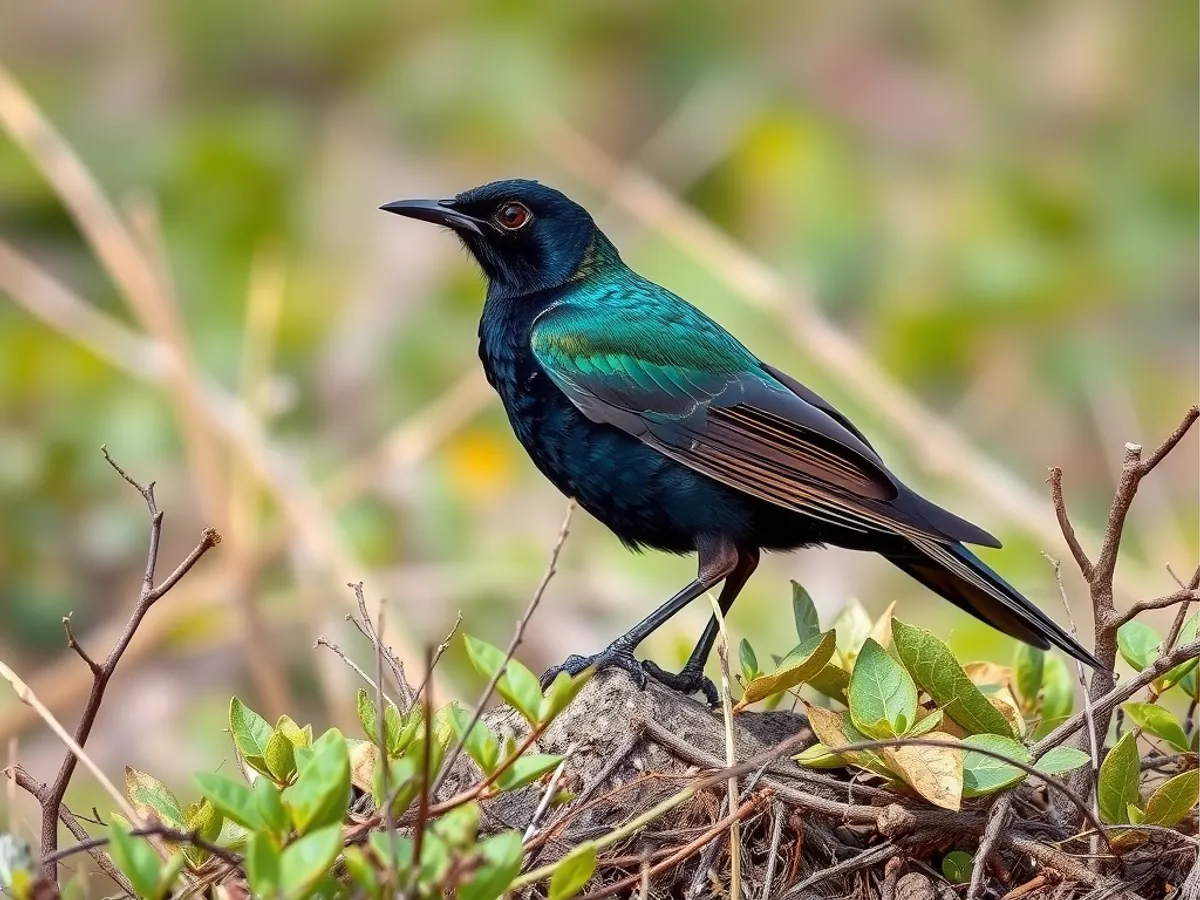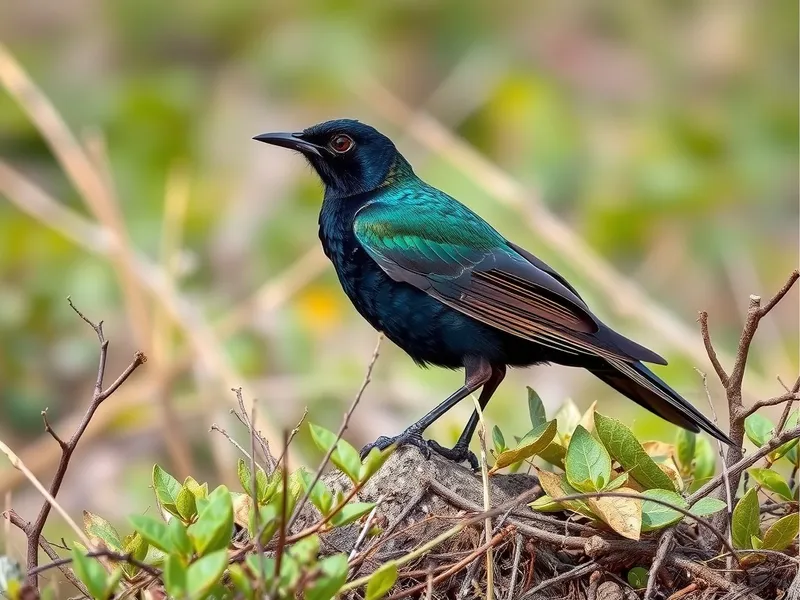
Superb Starling
Lamprotornis superbus

Meet the Superb Starling
The Superb Starling is a strikingly colorful bird native to East Africa, renowned for its iridescent blue-green back and chestnut belly. It is a social species, often seen in large, noisy flocks inhabiting open woodlands, savannas, and gardens. Superb Starlings are highly adaptable and thrive near human settlements, taking advantage of available food sources. Their cooperative breeding behavior and complex vocalizations make them fascinating subjects for behavioral studies.
Classification
Bird
Habitat
Savanna, open woodlands, and shrublands
Diet
Omnivore
Lifespan
5-15 years
Conservation
Least Concern
Weight
50–75 grams
📖Fascinating Facts
Iridescent Plumage
The Superb Starling's feathers contain microscopic structures that refract light, creating vivid blue and green iridescence.
Cooperative Breeders
Young starlings often help their parents care for new siblings by delivering food and protecting the nest.
Vocal Communicators
Their calls include whistles, clicks, and trills, and they use a variety of vocalizations to communicate within their flocks.
📋Detailed Description
The Superb Starling (Lamprotornis superbus) is a medium-sized passerine bird, measuring approximately 18–19 cm in length and weighing between 50–75 grams. Its plumage is highly distinctive: the head, upper breast, and back are a brilliant metallic blue-green, contrasting sharply with a white chest band and a rich chestnut-orange belly and flanks. The wings are similarly iridescent, with black flight feathers edged in blue, and the tail is short and square-tipped. The eyes are pale white, standing out against the dark facial mask, and the bill and legs are black. Superb Starlings are highly social, forming cohesive flocks that may number from a few individuals to over a hundred, often engaging in communal activities such as foraging and roosting. Their vocal repertoire is complex, including whistles, chatters, and harsh calls used for communication within the group. They are omnivorous, feeding on a wide range of insects, fruits, seeds, and occasionally small vertebrates, and are known for their opportunistic feeding near human habitation. The species exhibits cooperative breeding, with non-breeding individuals assisting in raising the young, a behavior thought to enhance group survival. Superb Starlings are adaptable to a variety of habitats, including savannas, open woodlands, shrublands, and cultivated areas, and are commonly found in proximity to villages and towns. Their striking appearance and gregarious nature make them a prominent feature of East African avifauna.
💡 Did you know?
Despite their brilliant appearance, Superb Starlings are not considered rare and are among the most commonly observed starlings in East Africa.
🔬Research & Sources
Wikipedia Summary
The superb starling is a member of the starling family of birds. It was formerly known as Spreo superbus. They are long-lived birds that can live over 15 years in captivity.
Last Modified: 5/26/2025
🎭Behavior & Social Structure
Superb Starlings display pronounced sociality, spending most of their time in flocks that provide safety from predators and facilitate efficient foraging. They are diurnal and begin their day with communal preening and vocalizations at their roost sites. Foraging is typically conducted on the ground, where they walk or hop in search of insects, larvae, spiders, and fallen fruits. They have been observed following large mammals or humans to catch insects disturbed by movement. Aggressive displays, such as wing flicking and vocal duels, are used to establish dominance within the group, but overt violence is rare. Cooperative breeding groups exhibit complex social hierarchies, with dominant pairs monopolizing breeding while subordinates help with nest defense, feeding chicks, and maintaining the nest. Superb Starlings are also known for their sentinel behavior, where individuals take turns watching for predators while others feed.
👶Reproduction & Life Cycle
Breeding in Superb Starlings typically coincides with the rainy seasons, when food is most abundant. They are monogamous within a breeding season, but extra-pair copulations are common. Nests are built in tree cavities, thorny bushes, or sometimes in man-made structures, using grasses, feathers, and other soft materials. The female lays 3–5 pale blue eggs, which she incubates for about 13–15 days. Both parents, along with helper birds (usually previous offspring or related individuals), feed the chicks. The nestling period lasts 17–23 days, after which fledglings remain dependent on the group for several weeks. Cooperative breeding increases reproductive success by improving chick survival rates and reducing predation risk.
🛡️Adaptations & Survival
Superb Starlings possess several adaptations for survival in variable environments. Their iridescent plumage is thought to play a role in social signaling and mate selection, while also providing some camouflage in dappled light. Their strong, straight bills are adapted for probing soil and leaf litter for invertebrates, as well as handling a diverse diet. Behavioral flexibility allows them to exploit human-altered landscapes, and their cooperative breeding system buffers against environmental unpredictability by sharing parental duties. Acute vision and coordinated group vigilance reduce predation risk from raptors and snakes.
🎨Cultural Significance
Superb Starlings are familiar to many East African communities and are often featured in local folklore as symbols of sociability and adaptability. Their striking colors and bold behavior make them popular subjects for birdwatchers and ecotourism, particularly in Kenya and Tanzania. In some regions, they are considered beneficial for controlling insect pests in agricultural areas. There are no widespread traditional uses or superstitions specifically associated with this species, but their presence is generally regarded as a positive sign of a healthy environment.
🔬Recent Research & Discoveries
Recent research on Superb Starlings has focused on their cooperative breeding system, revealing that group living provides both direct and indirect fitness benefits. Studies have shown that helpers are more likely to assist closely related breeders, supporting kin selection theory. Genetic analyses have uncovered high rates of extra-pair paternity, indicating complex mating strategies. Ongoing research is investigating the role of vocal communication in group cohesion and predator avoidance. Additionally, Superb Starlings are being studied as a model for understanding the impacts of urbanization on native bird populations in East Africa.
🎥Wildlife Videos

Superb Starling facts 🦜 found in East Africa Ethiopia, Somalia, Uganda, Kenya, Sudan, and Tanzania
birddocumentary superb starling documentary facts Picture https://commons.wikimedia.org/wiki/File:Superb_Starling_Portrait.jpg ...
Amazing Planet!

19th Eps - Meet The Superb Starling, The Beautiful Birds With High Solidarity
Meet The Superb Starling, The Beautiful Birds With High Solidarity After Black-Throated Laughingthrust and Chinese Hwamei, ...
The Aviary

SUPERB STARLING
ORNITHOLOGY AND WILDLIFE WATCHING

SUPER STARLING
It is considered to be one of the most thrilling displays of animal behavior on earth – a hundred thousand starlings in flight.
The John 10:10 Project
![Superb Starling [Lamprotornis Superbus]](https://i.ytimg.com/vi/ofCoLY7JwAA/hq720.jpg?sqp=-oaymwEcCOgCEMoBSFXyq4qpAw4IARUAAIhCGAFwAcABBg==&rs=AOn4CLDQ7DG3pMBKvRksXg4h7VCEJtMq8g)
Superb Starling [Lamprotornis Superbus]
In this video, we take a look at the superb starling. QUICK FACTS • Lifespan: • Size: 7.1 to 7.5 in • Wingspan: • Weight: 1.8 oz – 2.7 ...
Avi Birds

Unveiling the Beauty of Superb Starlings: Colors, Behaviors, and Habitat
Enter the colorful world of Superb Starlings, mesmerizing avian gems found in East Africa. Join us as we uncover the stunning ...
Cute Animals
🌍Habitat Information
The Superb Starling typically inhabits Savanna, open woodlands, and shrublands environments. Superb Starlings have adapted to their environments with specialized features and behaviors.
Primary Habitat:
Savanna, open woodlands, and shrublands
More detailed habitat information will be available soon.
🛡️Conservation Status
The Superb Starling is currently classified as Least Concern. Conservation efforts are crucial for preserving this species for future generations.
Common Threats:
- 🏠Habitat loss and fragmentation
- 🌡️Climate change impacts
- 🎯Hunting and poaching
- 🏭Human-wildlife conflict
⚠️Threats & Conservation Challenges
Currently, Superb Starlings are classified as Least Concern by the IUCN, with stable populations across their range. However, localized threats include habitat degradation due to agricultural expansion, overgrazing, and urbanization. In some areas, nest predation by snakes, monitor lizards, and birds of prey can impact breeding success. Despite these challenges, their adaptability and tolerance for human presence have allowed them to thrive, and there is no evidence of significant population declines at present.
🔬Scientific Classification
Scientific Name
Lamprotornis superbus
Classification Hierarchy
🔍 About Taxonomic Classification
Taxonomic classification is a hierarchical system used by scientists to classify and organize living organisms based on shared characteristics and evolutionary relationships.
The system moves from broad categories (Kingdom) to increasingly specific ones, with each animal's scientific name typically consisting of its Genus and species.
📝Community Notes
Share your observations and insights about the Superb Starling with our community of wildlife enthusiasts.
Join Our Community
Sign in to share your observations and connect with fellow wildlife enthusiasts.
Sign In to ContributeNo community notes yet
Be the first to share your observations about the Superb Starling!
Explore Superb Starling
Select a tab above to learn more about this amazing animal.
📸Photo Gallery
No photos available for this animal yet.
🌟Discover More Wildlife
Continue your journey of discovery with more fascinating animals from our database
